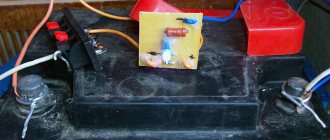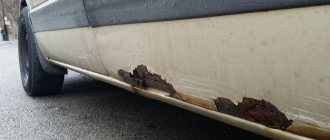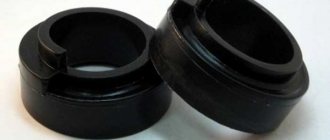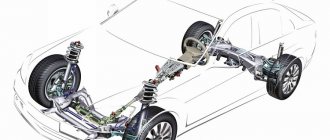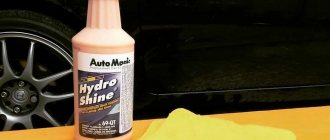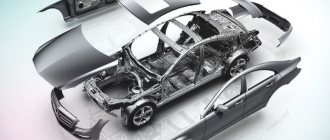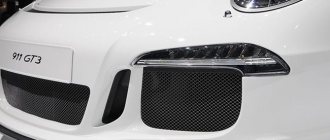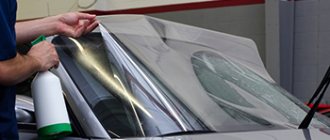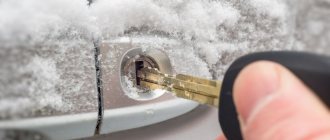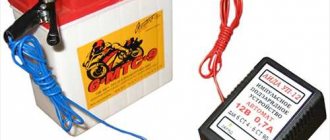There are many ways to protect your car from the harmful effects of corrosion. One of them is body galvanizing, which has been used in foreign countries for more than 30 years. Domestic production is also not standing still and is gradually introducing this technology. But most used cars do not have such protection, so it is quite reasonable to ask about galvanizing the body yourself, or at least its most vulnerable elements.
Description of body galvanization and its advantages
What is galvanizing a car body? At first glance, everything is quite simple. Galvanizing is a coating of a metal surface with a zinc-containing substance, which is aimed at limiting the effects of destructive corrosion. The difficulty is that galvanizing a body is not as easy as it seems. This is relatively expensive, troublesome and technologically difficult.
However, galvanizing is still used and is constantly being developed, this is especially true for foreign automotive companies that have been coating their cars with a protective compound for decades. This attention to galvanizing can be explained by the advantages that the car body receives after appropriate processing.
The main advantage is resistance to corrosion. The zinc layer itself does not react in any way to the effects of moisture and salts, which constantly attack the metal. It creates a barrier that protects steel from the destructive effects of an aggressive environment.
In addition, the advantages include the durability of such a coating. No other anti-corrosion treatment can match the service life of zinc coating.
Galvanizing a car - what is it?
Before we talk about galvanizing, let's figure out how rust appears on a car. The fact is that most modern bodies are made of sheet steel. This is justified by the high strength of the material and its relatively low cost compared to lighter metals. The price, for example, of aluminum is almost 3 times higher for the same volume, and carbon fiber is not worth mentioning. However, steel, being one of the iron alloys, is easily susceptible to corrosion.
So it turns out that if the paintwork is significantly damaged, the metal is exposed and comes into contact with air and water. The oxygen they contain enters into a chemical reaction with iron and starts the oxidation process. All this leads to the formation of a corrosion center, which gradually grows and destroys the metal. Sometimes the destruction is so severe that a through hole forms in the damaged area. So how can you protect strong steel from rust?
Due to contact with air and water, the corrosion process begins on the exposed metal.
To combat this phenomenon, a process such as galvanizing has long been invented. It works simply: the iron-containing alloy is coated with a thin layer of zinc, which forms a protective film on the surface. It is this film that prevents oxygen from reaching the metal and entering into a chemical reaction with it. This procedure is considered a highly effective means of corrosion protection.
In addition to galvanizing, tinning, that is, tin coating, is used to protect steel. However, in the case of cars, this method is considered less reliable and more expensive. If restoration of parts of the body is necessary, then tinning and galvanizing are used in pairs, since a layer of tin can smooth out the relief formed as a result of the removed layer of rust.
Galvanization protects metal from rust
Advantages and disadvantages of galvanizing
Like any other process, galvanizing has its positive and negative sides. Its advantages include the following factors:
- galvanization reliably protects the car from the aggressive effects of air, moisture and salts and prevents the appearance of corrosion on exposed areas of the metal;
- depending on the type of galvanization, the service life of the protective coating can range from 5 to 30 years;
- Zinc coating is more reliable and profitable than tin coating.
The procedure also has disadvantages, but they are much less impressive. The disadvantages of the method include the rather high cost if you use the services of specialists. Some types of galvanizing can be done independently, but this will require certain skills, time and strict adherence to instructions.
The protective zinc layer always deteriorates over time. The rate of destruction is from 1 to 5 microns per year.
Types of galvanization
There are various ways to galvanize a car body. They differ significantly not only in their technology, but also in price and the result obtained. Today, the following three methods are actively used:
- thermal or hot galvanizing;
- cold galvanized;
- galvanic galvanization;
Let's talk about each of these methods in more detail.
Thermal or hot galvanized
During the galvanizing process, the car body is immersed in a container of molten zinc of suitable depth. In this case, the metal temperature can reach 4000 °C.
The thermal method is considered the most effective, since the resulting zinc layer is from 2 to 15 microns. If the paintwork is damaged, it reliably protects the steel, and in case of minor damage to the zinc layer, it can sometimes repair itself. This occurs due to the appearance of zinc deposits, which seem to patch the damaged area. It is not surprising that the service life after undergoing such a procedure is at least 15 years, and if you treat the car with care, up to 30.
Hot-dip galvanizing is an expensive procedure that significantly increases the price of the car. Therefore, manufacturers use it mainly for premium and business class cars. It is impossible to carry it out at home.
Hot galvanizing of metal was described back in 1742. We owe the discovery to the French physicist and chemist Paul Jacques Malouen. And almost a century later, in 1836, Stanislas Sorel received a patent for the use of this method.
Hot galvanizing of the body is considered the most highly effective method of rust protection
Cold galvanizing
At its core, cold galvanizing is more like priming a car. The only difference is that the soil contains a large amount of finely dispersed zinc. A layer of such primer can protect the car body, but only in case of minor paint chips. If the zinc layer itself is damaged, corrosion will certainly appear.
This method of rust protection is the most unreliable, but at the same time the cheapest. Manufacturers of budget car models often use it so as not to inflate the final cost of the product.
However, how fair it is to call this method galvanizing is a big question. Most likely, this is just a marketing ploy to attract buyers who do not understand rust protection methods.
Nevertheless, cold galvanizing is well suited for DIY, as it does not require specific equipment or special conditions for the procedure.
Cold galvanizing is considered the most unreliable method of rust protection
Galvanic galvanization
Galvanic galvanizing occupies an intermediate stage between the cold and hot methods. On the one hand, it is quite reliable, and on the other, it has an acceptable cost and is suitable for use in a garage.
The method involves immersing a car part in a zinc electrolyte and then applying current. Thanks to it, strong bonds are formed between the steel and the zinc coating, which provide good protection against corrosion. Compared to thermal galvanizing, this procedure will be less reliable: the service life of the coating will be from 10 to 20 years.
Galvanizing is popular among mid-price car manufacturers.
Galvanic plating is chosen by most car manufacturers due to the optimal price-quality ratio
Zinc metal
There is another method of hot galvanizing: molten zinc is applied to metal sheets and then rolled. The resulting steel sheets with a thin layer of zinc are called zinc metal. This material can be used to make a body or parts that can resist corrosion. In this case, the protection will be lower than in the case of the thermal or galvanic method, but much higher than with cold galvanizing.
Sometimes steel is galvanized before being sent for rental.
Thermal diffusion and gas-thermal methods are also used for galvanizing metal. They are used in industry, but have a lot of specific points that make them unsuitable for galvanizing car bodies.
Briefly about factory galvanization of cars
Many automobile companies already galvanize the bodies of their cars at the production stage. Some people subject the entire body to this treatment. Others zinc only some elements. There are also those who process several parts completely, and the rest only on one side. For example, the bodies of the domestic Lada Kalina and some models of European manufacturers are subjected to this treatment.
Today, the manufacturer guarantees that during the production of Kalina, about 40% of the entire surface of body parts is galvanized. Some of them are processed by complete immersion in a galvanic bath. Others, less vulnerable, are coated only on the inside, where there is no full paint coating. The manufacturer claims that those elements of Kalina that are not galvanized are protected by a layer of primer. In addition, rotting of the interior of the body is much more difficult to detect, so the main emphasis is on them.
In addition to Kalina, it is worth giving examples of several foreign models that are also fully or partially galvanized. Among them are the following models:
- Many models are processed by thermal galvanizing;
- Volvo;
- some Ford models;
- Audi and the following manufacturers use galvanic plating on their vehicles;
- Honda;
- Alfa Romeo;
- Mercedes;
- Peugeot;
- Toyota and others.
Some of the manufacturers listed above galvanize the entire body of their models. This significantly adds to their cost, however, and their service life increases significantly.
Advantages and disadvantages
This method of rust protection is characterized by simplicity and fairly high efficiency.
On the other hand, galvanizing has its disadvantages:
- Firstly, treated surfaces cannot be harshly cleaned.
- In addition, proper implementation of the procedure requires skills, abilities and special equipment.
- Over time, the zinc layer deteriorates, so this protection must be renewed.
Against this background, the following tangible advantages need to be highlighted:
- reliable protection against corrosion;
- resistance to mechanical damage and aggressive environmental influences;
- various technology options that determine the durability of processed materials.
Thus, properly galvanized and painted car body will guarantee its safety and durability.
See also:
Electrochemical machine protection: what is it and what is it used for
Auto body galvanizing methods
Separately, a few words should be said about the methods of galvanizing a car. There are three main methods used here:
- Thermal – consists of immersing the body in a container with a special zinc-containing solution, which is heated to a certain temperature;
- Galvanic - the part or body is completely immersed in a bath of zinc dissolved in it. The part itself is connected to the negative electrode, and the container body to the positive one. Thus, positively charged zinc particles attach to the metal of the body;
- Cold galvanizing is very similar to the previous method. However, the part is not immersed in the container, but is treated with a zinc-containing electrode, which is also connected to the positive terminal of the power source.
The last two methods are often used for galvanizing a car body with your own hands at home. At the same time, independent galvanic processing is used much less frequently due to its complexity and high cost. These methods are worth considering in more detail, since it is quite possible to implement them with your own hands in a garage.
Types of galvanizing
| Hot galvanizing of metal | Cold galvanizing of metal |
We have professional equipment that allows us to work on rolled metal of any size, shape and install a durable galvanized layer that protects 100% from corrosion. The client can choose the coating thickness and other parameters - we will do everything according to your wishes. Our team can process large orders at once - we have enough technical means to implement any task.
Preparation of solution for galvanizing
Galvanizing a car body using these methods begins with preparing a zinc-containing solution. To do this you will need sulfuric acid and pure zinc. All this can be bought at the car market or in amateur radio stores. You will also need a power source - a regular car battery or charger will do. You will also need a container of appropriate size that is resistant to acid.
To prepare a zinc-containing solution, you need to put a piece of zinc in a prepared container at the rate of approximately 400 g of metal per 1 liter. Next, acid is poured into the container in small doses. In this case, you should adhere to safety precautions - you must protect your eyes, respiratory organs and hands.
When the zinc dissolves, you will need to make sure that the acid has completely reacted, for which you should add another piece of zinc to the resulting solution.
If no reaction with the release of bubbles is observed, then the solution can be considered ready for use. The resulting composition can be used both for the galvanic method of galvanizing with your own hands, and for cold galvanizing. How to do this is described in a few words below.
Do-it-yourself galvanizing of a car body
In everyday life, you can use both cold and galvanic methods of galvanizing a car. At the same time, the technologies for performing the procedure will differ, so we will consider each of them separately.
Safety precautions for self-galvanizing
In order for the galvanizing process to take place as efficiently as possible and not cause harm to health, you should strictly adhere to safety regulations.
- Carry out all work in places with good ventilation. This can be an ordinary garage with a good exhaust hood, but it is better to equip your workspace in the open air.
- Do not neglect personal protection: you must wear gloves, goggles and a respirator.
- Be as careful as possible if you make electrolyte for galvanizing yourself. This chemical process produces hydrogen, so the presence of flammable objects in the immediate vicinity may cause an explosion or fire.
Preparing the car
Before you start galvanizing, you should prepare the car. This applies to both cold and galvanic galvanizing methods.
- Remove old paintwork. It is best to use an abrasive in the form of sandpaper or a special grinder.
- If there is rust under the paint layer, then it also needs to be removed using an abrasive.
- Using harsh chemicals to remove paint is not recommended, but if you do, wash the metal surface with a baking soda solution and dry thoroughly.
- If you need to straighten the part, you can do it at this stage.
- Degrease the surface of the part with alcohol. Please note that you cannot use acetone or white spirit, as the heavy resins they contain will interfere with the bond of the metal with the zinc.
Galvanizing should begin immediately after degreasing. If you decide to do this on another day, then reschedule the last step.
Cold method
Cold galvanizing is less efficient than galvanizing, but it is much easier to carry out at home. Another advantage is that you can cover a large surface area with a protective composition, which is not possible with the electrolyte method. Therefore, this method is good to use for the upper part of the car: roof, pillars, hood and trunk lid. You can also cold galvanize doors or even the entire body.
Materials and tools
For cold galvanizing you will need the following materials and tools:
- special composition for cold galvanizing (pay attention to products of the Zinga, Galvanol or Zinol brands);
- spray gun or brush;
- individual protection means.
Galvarex brand composition is also well suited for cold galvanizing
Do-it-yourself cold galvanizing technology for a car
Applying a zinc solution is no more difficult than applying primer or regular paint. If you have experience in painting a car, then you will not experience any particular difficulties.
- Using a spray gun, apply the composition with smooth movements to the surface of the part. The layer should be thin and uniform.
- In some cases, it is more convenient to apply the zinc composition with a paint brush rather than with a spray gun. This method is also possible.
- After the first coat is applied, allow the part to dry completely. This may take from 30 minutes to 1 hour.
- Apply a second coat in the same way and let it dry.
Video: cold galvanizing:
Once the part is completely dry, you can apply automotive paint and varnish.
Galvanic method
With the galvanic method, the part that is being galvanized is dipped into a bath of electrolyte. In this case, the bath must correspond to the size of the part so that it can be immersed entirely. Because of this, it is impossible to galvanize the entire car body in this way: it will be difficult for you to find a container of the appropriate size, a sufficient volume of zinc solution and a mechanism for lifting and lowering the car. However, galvanizing is good if you need to process small and hard-to-reach parts that are located in the lower part of the car.
Materials and tools
For galvanic galvanizing you will need a certain set of materials and tools.
- zinc chloride or zinc sulfate as electrolyte;
- zinc electrode;
- acid-resistant electrolyte bath;
- car battery or other 12 volt power source;
- moisture-permeable fabric;
- baking soda solution;
- safety glasses, rubber gloves and a respirator.
You can buy all materials and tools in the auto store.
All of the above can be purchased at most automotive stores. But if you still have difficulty finding some specific materials, then use the following tips.
- If the auto store doesn't have something you need, look at a radio amateur store.
- You can prepare the electrolyte yourself by dissolving zinc in acid. Sulfuric acid can be purchased at an auto parts store. For every liter of liquid you will need 400 grams of metal. Place zinc at the bottom of the bath and then fill it with acid. After the reaction is complete and no more air bubbles appear, separate the colorless solution from the precipitate.
- A piece of zinc can be found if you disassemble a round battery.
Do-it-yourself car galvanizing technology
When all the preparatory work has been completed and the container with the electrolyte is ready, you can begin the galvanizing process.
- Take the part you are going to galvanize and connect the negative battery cable to it.
- Take a zinc electrode and connect the positive battery cable to it. Please note that this wire must not come into contact with electrolyte!
- Place the part and zinc in a reservoir with electrolyte.
- Turn on the voltage. Under the influence of current, zinc from the solution will gradually settle on the surface of the part. In this case, the current strength should not be higher than 1 ampere, since the galvanizing process must take place slowly. If you try to speed it up, the zinc layer will be too loose and will not be able to fully protect the metal from corrosion.
- If you did everything correctly, the zinc layer will be gray in color and look uniform.
- Remove the part from the electrolyte and then rinse in an alkaline solution to neutralize the acid.
Galvanic galvanizing is carried out by immersing the part in a zinc solution
Video: galvanic dip galvanizing
If you don't have access to a deep enough container or want to galvanize parts that are difficult to remove from the machine, you can use another variation of this process.
- Wrap the zinc electrode in several layers of cloth.
- Connect the positive cable of the battery to it, and leave the negative one at the ground of the car. Turn on the battery. In this case, the current strength, as in the previous case, should not be higher than 1 Ampere.
- Dip a piece of zinc into a container with electrolyte and wait until the fabric is completely saturated.
- Run the piece over the surface of the part you are galvanizing. Your movements should be smooth and soft, without jerking or pressing.
- The resulting zinc layer will look the same as in the first case: gray and uniform.
- Don't forget to neutralize the acid with a soda solution.
Galvanizing can also be carried out using a piece of zinc wrapped in fabric.
Galvanizing a small part
The car part to be processed is prepared accordingly. Traces of corrosion and old paintwork are removed. When cleaning, do not use aggressive paint removers. If you still cannot do without them, then the part should be treated with an aqueous solution of soda.
Next, the required amount of zinc-containing solution and the appropriate container are prepared. The negative terminal of the battery is connected to the part, and it is immersed in the solution. The capacitance itself is connected to the positive terminal and voltage is applied. For successful galvanizing of a small part, a voltage of 12 V and a current of about 1 A will be sufficient. The result of the treatment should be a part with a uniform gray coating. Next, the element is removed and thoroughly rinsed in an aqueous soda solution.
